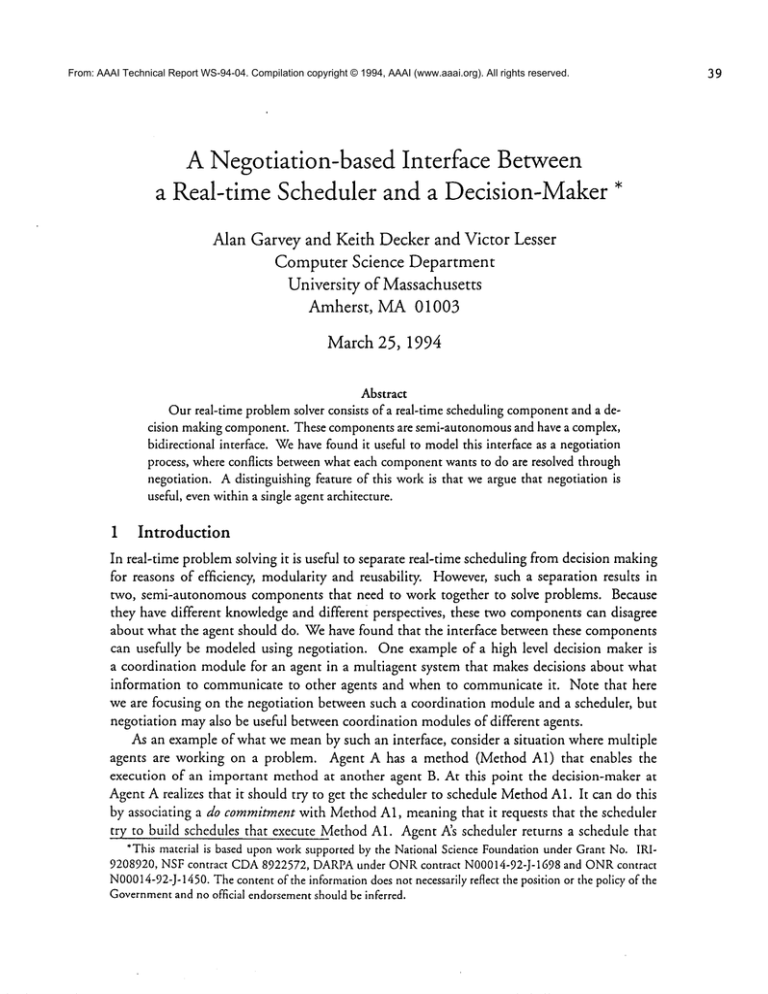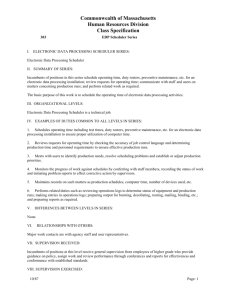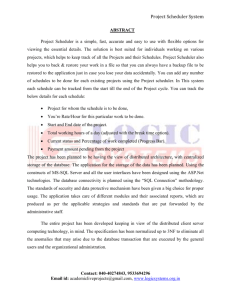
From: AAAI Technical Report WS-94-04. Compilation copyright © 1994, AAAI (www.aaai.org). All rights reserved.
A Negotiation-basedInterface Between
a Real-time Schedulerand a Decision-Maker*
Alan Garveyand Keith Deckerand Victor Lesser
ComputerScience Department
University of Massachusetts
Amherst, MA01003
March 25, 1994
Abstract
Ourreal-time problemsolver consists of a real-time scheduling componentand a decision makingcomponent.These componentsare semi-autonomousand have a complex,
bidirectional interface. Wehavefoundit useful to modelthis interface as a negotiation
process, whereconflicts betweenwhat each componentwants to do are resolved through
negotiation. A distinguishing feature of this workis that weargue that negotiation is
useful, evenwithina single agentarchitecture.
1
Introduction
In real-time problem solving it is useful to separate real-time scheduling from decision making
for reasons of efficiency, modularity and reusability. However,such a separation results in
two, semi-autonomous components that need to work together to solve problems. Because
they have different knowledgeand different perspectives, these two componentscan disagree
about what the agent should do. Wehave found that the interface between these components
can usefully be modeled using negotiation. One example of a high level decision maker is
a coordination module for an agent in a multiagent system that makes decisions about what
information to communicate to other agents and when to communicate it. Note that here
we are focusing on the negotiation between such a coordination module and a scheduler, but
negotiation mayalso be useful between coordination modules of different agents.
As an example of what we meanby such an interface, consider a situation where multiple
agents are working on a problem. Agent A has a method (Method A1) that enables the
execution of an important method at another agent B. At this point the decision-maker at
Agent A realizes that it should try to get the scheduler to schedule MethodA1. It can do this
by associating a do commitmentwith MethodA1, meaning that it requests that the scheduler
try to build schedules that execute MethodA1. Agent A’s scheduler returns a schedule that
*Thismaterial is based uponworksupportedby the National ScienceFoundationunder GrantNo. IRI9208920, NSFcontract CDA8922572, DARPA
under ONRcontract NOOO14-92-J-1698
and ONRcontract
N00014-92-J-1450.
Thecontentof the informationdoesnot necessarilyreflect the position or the policy of the
Government
and no official endorsement
shouldbe inferred.
B9
4O
completes executing MethodA1 at time 7. The decision-maker at Agent A tells other decisionmakers that it can committo giving them the result of MethodA1 at time 8 (allowing time for
communicationto occur). At the second agent B, the decision-maker receives this message and
passes it along to the scheduler, whichreports back that time 8 is too latenthe result is needed
by time 6. Agent A’s decision maker is informed of this feedback, and Agent A again invokes
its scheduler, now with a deadline commitment to complete Method A1 by time 5 (to allow
time for communication). Agent A’s scheduler returns a schedule that commits to completing
Method A1 by time 5 and Agent A communicates this information to the other agent, which
is nowable to complete its methodby the deadline.
Webelieve that the communicationbetween the decision-maker and the scheduler can best
be modeled as a process of negotiation. Negotiation is coordinated communication with the
goal of enabling or improving problem solving. [L~asri et al., 1992] describe the information
exchangedin negotiation in terms of proposals, critiquesj and explanations. The description of
the interface in this paper is arranged around these kinds of information. Wefirst describe
the basic input/output behavior of the scheduler in terms of proposals and explanations. We
then examine feedback in the form of critiques, either of the schedule as produced by the
scheduler or of the input specification. The paper concludes with a discussion of future
work. Related papers of ours discuss the details of the scheduling [Garvey et al., 1993,
Garvey and Lesser, 1993] and how the coordination modules communicate with one another
[Decker and Lesser, 1994].
2
Proposals and Explanations
Problem-solving begins when a problem to be solved arrives at the decision-maker. In our
work, problems are presented to the decision-maker as T/EMStask structures. The form of such
task structures is described in more detail in [Decker and Lesser, 1993]. Briefly, a problem
episode E consists of a set of independent task groups E = (~, ~,..., 7-n), each with a hard
deadline D(7-) and containing interrelated tasks T E 7". Within a task group, tasks form a
directed acyclic graph through the subtask relationship. The quality or value of a task T at a
particular time t (notated Q(T,t)) is a function of the quality of its subtasks (in this paper,
function is one of minimum(AND-like) or maximum(OR-like)). At the leaves of the
are executable methods M representing actual computations that can be performed. A single
agent mayhave multiple methodsfor a task that trade-offtime and quality. Besides the subtask
relationship tasks can have other relationships to methodsrepresenting the interactions among
tasks. Such relationships include enables(T, M, 0) meaningthat the enabling task 7’ must have
quality above a threshold 0 before the enabled methodMcan execute, facilitates(T, M, Cd, Cq)
meaningthat if the facilitating task T has quality above a threshold then the facilitated method
Mcan execute more quickly (proportional to Ca) and/or achieve higher quality (proportional
to Cq), and hinders(T, M, Ca, Cq) (the opposite of facilitates) whereif the hindering task
quality, then the hindered methodill will achieve reduced quality and/or increased duration
if it is executed. Note that these relationships occur from a task or method to a method. A
relationship from Task A to Task B is translated to relationships from Task A to all methods
below Task B.
Muchof the discussion in the remainder 0fthis paper is grounded in a multiagent example
scenario. In the multiagent scenarios each executable method is executable by exactly one
41
agent, howeverseveral agen.ts mayhave identical methods for achieving quality for the same
task. The goal of the decision-makers is to work together to produce the highest possible
quality for as manytask groups as possible, i.e., each attempts to maximizethe global utility
measure U(E) = ~[]7-eE Q(7-,D(7-)). This is not straightforward, because each agent
only somepart of the total task structure, and it maybe the case that no agent sees the entire
structure. Thus the decision maker cannot simply ask the scheduler to optimize this global
criteria. One kind of information that agents can communicateto one another is information
about the task structures that they see. The decision-makers are responsible for coordinating
their activity so as to avoid redundant methodexecution and allow relationships that extend
across agents to be exploited or avoided as appropriate. The role of the scheduler is to schedule
execution of local methodsaccording to criteria provided by the decision-maker.
2.1 Scheduler Inputs
The decision-maker proposes to the scheduler that a solution to each newlyarriving task group
be added to the schedule of methods to be executed. A basic request to the scheduler (its
input) consists of four things: the task structures to be scheduled, a set of commitments,a set
of non-local commitments, and a runt:me indication.
Deadline:25
~
DeadlineCamrnitme
Q.45,T.
"F~rly"
method
(executable
subtasktaskl
relationship
enables relationship
~
~
facilitates relationship
~~_~
Figure1: Anexample
of a complete
input specificationto the scheduler.
The task structures to be scheduled Es, should include some indication of what aspects
t
"
of those structures have changed since the scheduler was last invoked. If we write BA (X) to
indicate what agent A believes at time t about X, then the scheduler at agent A at time t has
access to B~(E), and BS,(E) \ BS~-I(E).
The set of commitmentsC are constraints that the invoker would like the scheduler to try
to satisfy. Wehave defined three types of commitments:
¯ C(Do(T,q)) is a commitmentto ’do’ (achieve quality for) T and is satisfied at the
t whenQ(T, t) _> q. A ’don’t’ commitmentis also possible.
¯ C(DL(T,q, tat)) is a ’deadline’ commitmentto do T by time tat and is satisfied at
the time t when [Q(T,t) >_ q] A [t < tdt]. A C(Do(T,q)) is really shorthand for
C(DI_(T,q,D(T))).
¯ C(EST(T,q, test)) is a ’earliest start time’ commitmentto not begin work on T before
time test and is satisfied at the time test iffk/t <__test, Q(T, t) < q.
The importance of local commitmentssuch as these are as soft constraints on the possible
solutions. Anyscheduler that can schedule real-time method executions can already deal with
42
hard constraints such as deadlines and earliest start times. Soft commitmentsare needed to
handle the coordination of multiple agents where there is more than one wayto solve a task or
wherethere are soft coordination relationships such as facilitates. Wheninvoking the scheduler
in a query mode,the decision-maker mayalso supply the symbolic values ’early’ for a deadline
commitmentand ’late’ for an earliest start time commitment,which indicates to the scheduler
that it should attempt to satisfy the commitment
as early or late as possible.
The set of non-local commitments NLCare commitments that the scheduler can assume
will be satisfied. These are of the form of the commitmentsmentioned above and tell the
scheduler to expect to receive the indicated results at the indicated time.
In multi-agent problems, non-local commitments can be used to communicate work that
will be done by other agents. This componentis necessary for achieving coordinated behavior in
complex domains. These non-local commitmentsmight be created at run time by the decisionmakers, or they might be derived from pre-defined ’social laws’ [Shohamand Tennenholtz,
1992] that all agents agree to, or are constructed to, satisfy. Anothereffect of NLCsin multiagent problemsis the triggering of non-local effects (coordination relationships); each non-local
deadline commitment,for example, implies an earliest start time on the ’affected’ end of any
relationships. For hard relationships like enables this implies a hard earliest start time; for soft
relationships it actually expandsthe search space (since each affected task can be started either
before or after the earliest start time with different results).
Various mechanismsfor controlling the runtime of the scheduler that we do not discuss
here.
2.2
Basic Scheduling Mgorithm
In general, these scheduling problems are NP-Hard. For that reason, heuristic scheduling is
necessary for all but the smallest problem instances. Werefer you to [Garvey eta/., 1993,
Garveyand Lesser, 1993] for a detailed discussion of the scheduling algorithms that we use.
2.3
Scheduler Output
The output from the scheduler after an invocation should include at least one valid schedule,
a list of satisfied commitments,a list of violated commitments
with alternatives, an indication
of tasks that should be scheduled but are not, and an indication of the value of each returned
schedule with respect to somefixed set of criteria.
A set of valid schedules S is returned that do a satisfactory job of satisfying the problem
given to the scheduler. An individual schedule S E S consists of at least a set of methods
and start times: S = { (M1, tl), (M2, t2),..., (Mn, tn) }. This output is of course necessary,
and forms the initial proposal in the negotiation process. The remaining items provide an
explanation of this proposal.
The next three items returned (satisfied commitments,violated commitmentswith alternatives, and multicriteria schedule values) are not necessary for the scheduler to provide, because
they can all be derived mathematically from the schedule itself and the set of non-local commitments. However, for practical implementations, the scheduler often has this information
at hand, or can collect it during schedule generation, and it would be expensive to recompute.
The set of input commitmentsthat are satisfied in a schedule Satisfied(S) is returned
(VS’ E S, Satisfied(S) C C). If the scheduler supports symbolic local commitmentslike ’early’
deadline commitmentsand ’late’ earliest start time, then it must also supply an indication of
43
whenthe commitmentis expected to be satisfied in the schedule SatTime(C, S). For example,
if C1 = DL(T, q, ’early’) and C1 Satisfied(S) th en SatTime(C, S)
= r ai n t <D(T)s.t.
Qest(T,t,S)
>_
The set of input commitmentsthat are violated in a schedule Violated(S) is returned. For
each violated commitment, a proposed modification to the commitmentthat the scheduler is
able to satisfy (Alt(C,S)) is also returned. For earliest start time and deadline commitments
this involves a proposed new time and/or minimumquality. For do/don’t commitments this
involves a recommendedretraction or a reduced minimumquality value. For example, for
a violated deadline commitment C(DI_(T, q, tat)) Violated(S) th e fu nction Al t(C, S)
returns an alternative commitmentC(DL(T, q, t~t)) where t~ = mint such that Q(T, t) > q
if such a t exists, or NILotherwise.
The knowledgethat certain commitmentsare satisfied or violated is absolutely necessary to
the decision-maker that uses commitments, regardless of the domain.
An indication of the "value"of the schedules that were returned accordingto several objective
criteria. Someof the objective functions that can be measuredinclude the total quality for
all scheduled task groups, 1 the number of task groups that do/do not complete before their
deadline, the amountof slack time available in the schedule to allow easy scheduling of new
tasks and/or allow time for tasks to take longer than expected to run, and the number (or
weighted value) of the commitmentsthat are not satisfied in the schedule.
Complexreal problems invariably involve multiple evaluation criteria that must be balanced
with one another; we view this balancing as the role of the decision-maker, and the scheduler
attempts to maximizethe current criteria, often returning multiple schedules (e.g., one that
best satisfies each of the current criteria.) Whilethe ability to evaluate a schedule with respect
to certain criteria could be implementedoutside of the scheduler, the ability to attempt to
optimize certain criteria can only be placed in the scheduler.
A minimal list of tasks in the task structure that the schedule is notproviding quality for
but would need to have quality to allow their task group to achieve non-zero quality.
Final Quality: 40 Commitment
IF:Q"
D"’ITota,
Duras,nn:
,6at--7 satisfied:
B:Q’45.D’7
I
I F:Q’45,D’4
IA: Q-20, D-8
0
2
Final Quality: 40 Commitment
satisfied:
TotalDuration:ll attime7
I
Final Quality: 20 Commitment
violated:
Total Duration:8 Noalternative
]
4
6
8
10
12
14
16
18
20
Figure2: Anexampleof the outputof the schedulerfor the exampleproblemgivenabove.
A summaryof the output of the scheduler for the example problem given above is shown
in Figure 2. In this examplethree schedules are returned. The bottom one produces a fast, low
quality result, violating the given deadline commitment
because no quality is ever generated for
the committed task. The middle schedule produces the highest possible quality in the fastest
possible time, satisfying the deadline commitmentat time 7. The top schedule produces the
highest quality possible completely locally, not relying on the given nonlocal commitment,
also satisfying the deadline commitmentat time 7. Whichof these schedules is chosen by the
lThis couldbe a weightedsumif task groupimportance
varies, or somemorecomplex
functionif desired.
decision-maker depends on the current evaluation criteria. If the fastest possible, acceptable
result is desired, perhaps because of a large workloadof other tasks, then the bottom schedule
is chosen. If the best possible result in the minimum
possible time is desired, the the middle
schedule is chosen. If the best possible result that does not rely on other agents is desired
(possibly because of other work that those agents need to do or a concern about the other
agent’s reliability) then the top schedule is chosen.
3
Critiques and Repair
Critiques are expressions of dissatisfaction with particular parts of a proposal. They can be
madeinternally by the scheduler as part of the schedule creation process or externally by the
decision-maker. In both cases the scheduler attempts to respond to the critique by repairing
the schedule. Repair consists of deciding what part of the schedule to modify (not necessarily
the exact part criticized by the critique) and deciding what modification to make.
At this point in our research, critiques are only generated internally by the scheduler. After
the scheduler has generated a new schedule it critiques it looking for a few kinds of specific
problems. If these problems are detected it attempts to repair them by adding new methods or
idle time to the schedule. In the future we intend to add manymorecritiques and repairs to the
scheduler, including critiques from outside the scheduler. Informally, wecan consider a request
from the decision makerto schedule a task ’early’ as a critique (i.e., ’I like this schedule, but
try to movethis task up earlier in the execution order’). Wealso intend to study the tradeoffs
associated with critiques, comparing the improvement in performance with the added runtime
COSt.
4
Example
Wewill nowgive a short example illustrating the ebb and flow of communicationbetween the
local scheduler and the decision makerin our implementation. Let the three classes of schedules
typically returned by our scheduler be namedby their primary evaluation criteria: BC(best
committed), BQ(best quality), and BF (best finish time)--remember that the local scheduler
is heuristic and cannot optimize these criteria. Initially the local scheduler will proposea set of
schedules without any local or non-local commitments(BC = BQ). The decision-maker uses
the BQschedule as a starting point, looking at the potential of various activities to help or
interfere with activities at other agents. For example, Task A at Agent1 maybe in the current
BQschedule, and be believed to enable tasks at Agent 2. Agent 1 can then locally commit to
doingtask A, asking the local scheduler to scheduleit as early as possible (effectively, a critique).
The local scheduler then returns a new set of possible schedules and their evaluations. If in
the decision-maker’s eyes Task A finishes early enough, it maymakea non-local commitmentto
Agent 2 about the completion deadline for Task A. Agent 1 maydo this several times, creating
several local commitmentsand possible non-local commitments. The local scheduler may not
always be able to make the proposed local commitment, or making the new commitment can
cause older commitmentsto be violated. In this case the decision maker will often jettison
the new commitment(which, because it has not been communicatedto other agents yet, is
painlessly retracted). Other agents will also be doing similar scheduling activities, so non-local
commitments will be coming in from them. At some point a new task group may arrive, and
Agent 1 may not have enough computational resources (or the scheduler may not be able to
45
find a schedule) to keep all commitmentsand produce the best quality schedule (BC :fi BQ).
At this point the decision maker has several choices: it can choose from one of the existing
schedules or alter some set of local commitmentsand try to reschedule. In our implementation
the decision maker always chooses from the existing set of schedules, and chooses the one with
the best global utility in the decision maker’s view. Global utility maydiffer from local quality
because the local scheduler does not have a complete view of the problem2. After choosing a
schedule, the decision-maker issues retractions for local commitmentsthat have been violated,
and new commitments when the violated commitment has an alternative.
Thus the local
scheduler and decision-maker carry on a fairly complex back-and-forth dialog, each bringing
their unique viewpoints to the control of an individual agent.
5
Conclusions
Wehave presented the details of a complex, bidirectional interface between a decision maker
and a scheduler. The major ideas presented here, including the details of the interface, have been
implemented in a multi-agent problem-solver [Decker and Lesser, 1994]. The interface was
developed in response to the real requirements of building this complexproblem-solver to solve
randomly generated task structures in the T/EMSenvironment. Wehave found the schedules
produced and runtime of our scheduling algorithm to be acceptable for this problem-solver,
but other applications might require more complexschedulers or faster schedulers.
Howshould we evaluate the interface? We have empirical evaluations of the system
as a whole (multiple agents, each with a decision-maker and a local scheduler solving shared
randomlygenerated problems), and of the scheduler in isolation, but neither of these evaluations
cuts to the heart of the interface between the decision-maker and local scheduler in a single
agent. Whatwe have tried to do is argue for the necessity of various parts of the interface
(i.e. problem specification, local and non-local commitments,a set of valid output schedules)
and the efficiency of providing someother useful information (i.e. violations, alternatives,
evaluation, tasks needed but without quality, runtime controls).
In the future we would like to extend the system in a few directions. Oneinteresting area
to explore is doing asynchronous, concurrent decision-making and scheduling. Both activities
could go on simultaneously with both systems evaluating what requests to respond to first and
howto respond to changing environments. Another area we intend to investigate is the effect
of uncertainty in the duration and quality of methods. Suchuncertainty increases the difficulty
of scheduling and potentially reduces the reliability of commitments.
References
[Decker and Lesser, 1993] Keith S. Decker and Victor R. Lesser. Quantitative modeling of
complexcomputational task environments. In Proceedings of the Eleventh National Conference
on Artificial Intelligence, pages 217-224, Washington,July 1993.
2Thisis similarto the waydecisionscanbe madeunderdifferentviewpoints
in concurrentengineering
systems:
locally, I mightpreferalternativeAto alternativeB, but if yousay alternativeBis unworkable
or impossible
from
yourviewpoint,I can makea decsionto pursueAevenwithoutbeingable to derive that result locally. This is
anotherreasonwhyweseparate local schedulingfromdecision-making.
[Decker and Lesser, 1994] Keith S. Decker and Victor R. Lesser. Designing a family of coordination algorithms. ComputerScience Technical Report 84-14, University of Massachusetts,
1994.
[Garvey and Lesser, 1993] Alan Garvey and Victor Lesser. Design-to-time real-time scheduling. IEEETransactions on Systems, Manand Cybernetics, 23 (6): 1491-1502, 1993.
[Garvey et al., 1993] Alan Garvey, Marty Humphrey,and Victor Lesser. Task interdependencies in design-to-time real-time scheduling. In Proceedingsofthe Eleventh National Conference
on ArtificialIntelligence,
pages 580-585, Washington,D.C., July 1993.
[L~asri et al., 1992] Brigitte L~asri, HassanL~asri, Susan Lander, and Victor Lesser. A generic
model for intelligent negotiating agents. International Journal on Intelligent Cooperative
Information Systems, 1(2):291-317, 1992.
[Shohamand Tennenholtz, 1992] Y. Shohamand M. Tennenholtz. On the synthesis of useful
social laws for artificial agnet societies (preliminary report). In Proceedingsof the Tenth
National Conferenceon Artificial Intelligence, pages 276-281, San Jose, July 1992.







